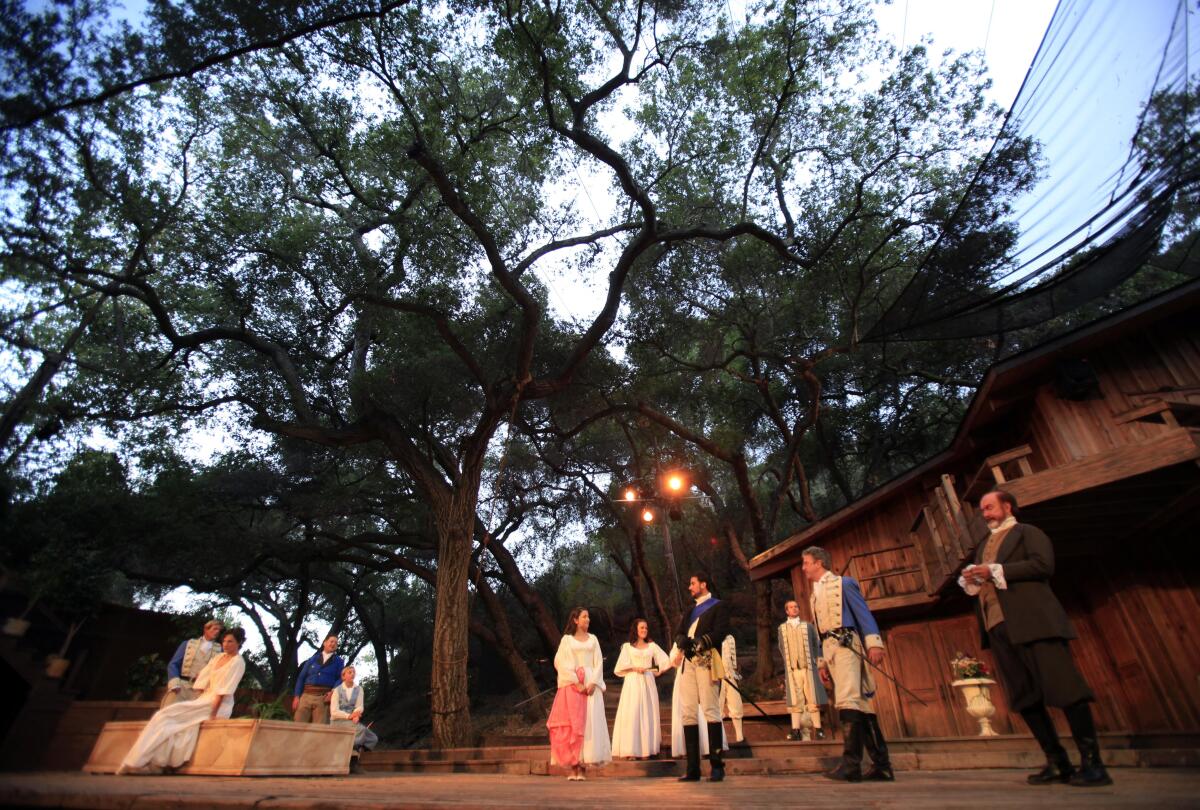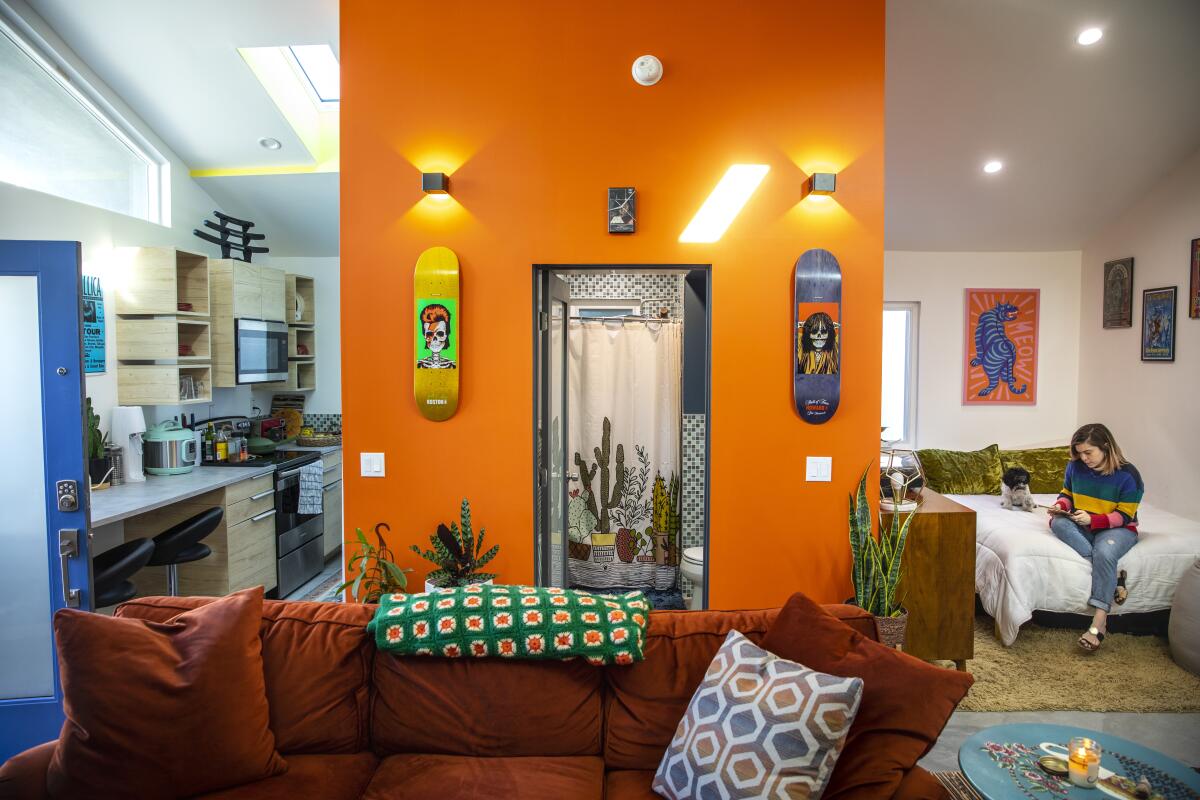Essential Arts: A compelling anti-tourist California in new photo show
- Share via
So what will you be wearing to the vaccine? I’m thinking casual: a little off-the-shoulder number with an updo. I’m Carolina A. Miranda, arts and urban design columnist at the Los Angeles Times, with your weekly dose of culture news and container ships.
The California gaze
Golden sunsets. Surfers on a beach. The Hollywood sign lording over Los Angeles from a hilltop. Those are the visual tropes of California. And you won’t find any of them in “Golden Hour: California Photography from the Los Angeles County Museum of Art,” now at the Museum of Art & History in Lancaster. (It’s open!)
Instead, the exhibition, which is drawn from LACMA’s photography collections and organized by the museum’s assistant curator of photography, Eve Schillo, mixes old and new acquisitions in a series of thematic installations centered on themes such as landscape, history, representation and the dystopian.
Industrial landscapes, coastal gloom, Ed Ruscha’s deadpan photos of parking lots and An-My Lê’s images of military exercises in the California desert all work their way into the show. This is not bucolic “Cali” served up for tourist consumption. It is the California of extraction and compromised environments and the military industrial complex.
The themes allow for some stirring juxtapositions.
Laura Aguilar’s “Three Eagles Flying,” which shows the artist nude and bound between Mexican and American flags, hangs within sight of Willie Robert Middlebrook’s powerful photographic installation “In His ‘Own’ Image” (which on its own is worth the drive up to Lancaster).
Made in 1992 after four policemen were acquitted for the vicious beating of Rodney King, the piece features 16 self-portraits in which Middlebrook faces the camera in a state of sadness, frustration and exhaustion. Experimental photo processing techniques on some of the images result in prints that reveal just fragments of his face — as if he might be disappearing into the picture. It’s a struggle between the affirmation of presence and a hold on existence that is tenuous.
Make the most of L.A.
Get our guide to events and happenings in the SoCal arts scene. In your inbox once a week.
You may occasionally receive promotional content from the Los Angeles Times.
“The work is about one man, an African American Male,” Middlebrook once wrote. “Through the expressions on his face, the viewer gets to share some of what was felt ... what he felt on April 29,1992, and prior to that.”
“Golden Hour” marks a posthumous reunion for Aguilar (who died in 2018) and Middlebrook (who died six years prior). They were friends and colleagues in life, united by an interest in photography and the concerns of invisibility and representation.
Elsewhere, the show unearths the everyday in Los Angeles, a city that still remains a one-dimensional Hollywood set in the popular imagination.
A ‘70s-era image by Ave Pildas shows a man joyfully offering the camera a Black power salute. A more contemporary, black-and-white photograph by Rafael Cardenas (whom I’ve written about in the past), captures taqueros lost in their labors in the dim of night.
Particularly poignant, at a moment in which we find ourselves reconsidering the narratives that define our places, is a hypnotic 2010 video by filmmaker Rodrigo García titled “7th and Alvarado,” which shows a band of Mexican revolutionaries materializing like ghosts on that street corner. It is Mexican history making its presence known — though not without its attendant complications: The revolutionaries, who gallop dramatically through the area on horseback, have with them a prisoner, and he is bound.
If cities were to dream, I imagine this is what that L.A.’s dreams would look like.
“Golden Hour: California Photography from the Los Angeles County Museum of Art,” is on view at the Museum of Art & History (665 W. Lancaster Blvd., Lancaster) through May 21. Visits are currently by appointment via their website, lancastermoah.org.
Art after the coronavirus
Dare I even write that? Maybe it’s not so much art after the coronavirus as it is art amid a waning pandemic. The Times’ Jessica Gelt looks at how L.A. theater companies, which have been shaken to the core by more than a year of closures, are looking at making tentative comebacks this summer through outdoor productions. “Institutions that have outdoor areas are intent on making use of that space, while groups that don’t are focused on securing an outdoor site,” she writes. “Large venues that would lose money operating at reduced capacity are instead mostly planning online shows for summer while hoping for a brighter, less distanced fall.”

Gelt also writes about how the Music Center has just received a “healthy building” verification, which represents a high standard for air quality at its four venues: Disney Hall, the Dorothy Chandler Pavilion, Mark Taper Forum and the Ahmanson Theatre. This doesn’t mean that you’ll be able to immediately toss your mask and go see a crowded show — simply that the space meets a standard for filtration, ventilation and overall hygiene of air systems.
Art’s ripple effects
Times theater critic Charles McNulty writes about why diverse representation is so critical in the arts — as well as in the honors that are bestowed upon them: because art can make an emotional connection that pure intellectualism can’t. “The invitation from artists to explore new frontiers, is simultaneously an opportunity for self-expansion,” he writes. “Our sensibility is a source of pleasure and should be indulged. But it’s equally vital that we venture beyond our backyards. The theater, at the highest level, is a school, and its curriculum is empathy.”
Enjoying this newsletter? Consider subscribing to the Los Angeles Times
Your support helps us deliver the news that matters most. Become a subscriber.
More than a year ago, culture writer Ashley Lee saw Florian Zeller’s play “The Father” — about a man who is losing his mental faculties — with her own father at the Pasadena Playhouse. She revisited the work in the company of her father — this time as the Oscar-nominated film version starring Olivia Colman and Anthony Hopkins (which was also directed by Zeller). These viewings led to a heartfelt conversation between the two about aging and care and memory. “Aging is so difficult,” he tells her, “because I think everyone has secret dreams about what that time will be like.”
Sidewalk Project is a nonprofit that takes an artistic approach to social services and harm reduction on skid row. Pre-pandemic, it staged monthly block parties, where unhoused people could also access basic necessities. Post-pandemic, the group has focused on distributing supplies and maintaining a needle exchange. It’s a personal cause for founder Soma Snakeoil. An artist, punk rocker, sex worker and playwright, she tells contributor Stephanie Mendez, “My journey to sobriety was a harm reduction journey.”
Brooklyn performer Julie Piñero lost her partner, Jose Zambrano, to a random attack in 2019. Her experience with this loss led her to pen a one-woman play, “Delejos,” which she is currently performing on Zoom. “This piece is a continuation of that promise we made together to be doing comedy together, to be doing live music together and to also do VR together,” she tells Christian Orozco.
Art and design
Countless items unscrupulously harvested from archaeological sites in Asia have ended up in Western museums. Thanks to the research and efforts of Thai archaeologist Tanongsak Hanwong, two of those objects will be going back home: a pair of lintels from temples in northeastern Thailand that had ended up at the Asian Art Museum in San Francisco. Times data journalist Jennifer Lu recounts how they ended up in the museum’s galleries. The story involves a noted American collector of Asian antiquities, a French dealer, a London auction house and the Department of Homeland Security.
I recently wrote about how some architects are bringing high design to the granny flat (otherwise known as an ADU, or accessory dwelling unit). Now my colleague Lisa Boone writes about how architect Alexis Navarro, founder of ANDesign, has created an ADU, Casita L.A., that is small and cost-effective. His construction costs: less than $100,000 over “536 meticulously planned square feet.”

Plus, Kriston Capps over at Citylab looks at how the ADU market has created a niche for modular design in California.
Essential happenings
Last week my husband made me sit through “Zach Snyder’s Justice League,” a four-hour steroid-fest that felt like 72 trailers in search of a movie. Thankfully, he and HBO Max have made up for it with the illuminating Spanish television series “Veneno,” about the life of the late Cristina Ortiz Rodriguez, the transgender television personality from the 1990s known as “La Veneno.” The show is poignant, agonizing, joyful, tragic, hilarious and thrilling. (The Spanish have a way with darkness and absurdity.)
The Times’ Laura Zornosa tells the story of how the series came to life (with a queer and transgender cast and crew). And New York magazine critic E. Alex Jung describes it as “a jolting reminder of how big the world is.” Do yourself a favor and watch. And if you speak Spanish, watch it in Spanish — because the language is delightfully vulgar.
If you’re not glued to HBO Max with a tissue and a bottle of rioja, Matt Cooper comes through with 19 culture picks for the weekend, including an online reading of Larissa FastHorse’s satirical “The Thanksgiving Play” and a stream of L.A. Opera’s “The Anonymous Lover,” by 18th century composer Joseph Bologne.
In time for Passover: a group of Los Angeles artists have created an audio art project inspired by the story of Exodus that also functions as a self-guided tour of different sites in Highland Park. “Exodus 2021,” as the piece is titled, is narrated in the second person: which means you, as listener, are Moses. And its narrative pieces are seamlessly mixed with some intriguing musical-sound art hybrids.
Passages
Elsa Peretti, a runway model whose elegant jewelry designs, inspired by the work of artists such as Henry Moore and Alexander Calder, were big sellers at Tiffany & Co., is dead at 80.
Daniel Wolf, a gallerist who helped build a market for photography and helped the Getty assemble its collection in the medium, died in January at the age of 65.
Ernesto Mallard, a leading figure of the Mexican op-art movement, has died at 89.
George Segal, the former banjo player who went on to earn an Oscar nom for his performance in 1966’s “Who’s Afraid of Virginia Woolf?”, is dead at 87.
Jessica Walter, the versatile award-winning actress who appeared in Broadway productions and major motion pictures by directors such as Sidney Lumet and Clint Eastwood, and whose lifetime of serious roles was capped later in life by the wonderfully caustic Lucille Bluth in “Arrested Development,” is dead at 80. Times critic Robert Lloyd has an appreciation of her smartly wicked acting persona.
I’ll be pouring a martini out for Walter, who knew just how to capture a status-obsessed Newport Beach socialite.
In other news
— AIA California has named the Irvine-based LPA firm of the year. In addition, Barton Phelps and Charles Eley were awarded lifetime achievement awards and John Kouletsis received a separate lifetime achievement award in medical design.
— Louis Grachos is resigning from his post as director of the Palm Springs Art Museum — just as the museum is preparing to reopen. He will remain in the post until this summer.
— More than 100 San Francisco artists will receive a guaranteed income of $1,000 a month for six months as part of a new pilot program funded by the city and managed by the Yerba Buena Center for the Arts.
— Critic Marvin Heiferman lost his husband, critic Maurice Berger, a year ago to COVID-19. He writes about the role of photography in his grieving process. A beautiful essay of words and images.
— Ben Davis did the rest of us a favor and combed through all 5,000 images in Beeple’s “Everydays” and it’s ... not inspiring.
— “Imposing monsters and gentle giants.” A tour of the D.C. area’s brutalist buildings.
— A great piece by Rachel Hawley in AIGA’s Eye on Design about the default illustration style of Big Tech.
— And it’s on! Streetsblog has begun its brackets tourney for its Sorriest Bus Stops of 2021. L.A. hasn’t materialized yet, but I’m sure we’ll come through with something worthy.
And last but not least ...
I’m obsessed with the container-ship-stuck-in-the-Suez Canal story. Note to Michael Heizer: Imma let you finish, but this is the best work of land art I’ve ever seen.

The biggest entertainment stories
Get our big stories about Hollywood, film, television, music, arts, culture and more right in your inbox as soon as they publish.
You may occasionally receive promotional content from the Los Angeles Times.




